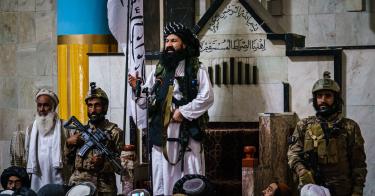As if it were not enough that the Taliban took complete control of Afghanistan—imposing its will and murderous tactics on innocent citizens; endangering Americans still present in the country; and complicating efforts to extract Afghans who provided important support, such as translators—it gets worse.
The Taliban has also seized tens of billions of dollars of military equipment and supplies, which were formerly under the control of Afghan security forces. More than $28 billion was spent equipping the Afghans between 2002 to 2017. Expenditures after that are harder to come by, but since deliveries were continuing until just last month, it is safe to assume that the total amount is much more.
Indeed, the Taliban captured essentially all the necessary ingredients to fully equip both an army and an air force, spanning the gamut from 600,000 rifles and machine guns; 76,000 vehicles, such as high-mobility multipurpose wheeled vehicles, armored trucks, and pickups; radios, night vision googles, and drones; and 208 helicopters and fixed-wing aircraft.
Of equal significance are the amounts of supplies it acquired in the process: millions of rounds of ammunition, spare parts, grenades, uniforms, boots, meals, fuel, and rockets—enough to sustain Taliban military efforts for years.
While some have been concerned about the Taliban’s use of the aircraft left behind, Heritage Foundation senior fellow of defense John Venable recently explained that should not be much of a worry. About 25% of Afghanistan’s air force fled to nearby countries, taken there by fleeing Afghan pilots. The fate of those aircraft is uncertain. “For the aircraft left behind,” said Venable, “lack of spare parts, contract support, and maintenance means few flyable platforms.”
For the same reasons that the Afghan air force was crippled when the Biden administration removed all the contractors who were performing maintenance for these aircraft, the Taliban will also struggle to keep even a few flying. And that assumes it has trained pilots.
Nor do we really need to worry about the capture of this equipment revealing any American military secrets. No advanced technology was captured, like F-35 jet fighters or Patriot missile systems. What the Taliban got was basic stuff—but it was better than what it had—and it got a lot of it.
There are plenty of pictures of Taliban fighters now holding the U.S. military’s latest small arms, such as the M4 carbine or the M16A4 rifle. These are far superior weapons to the AK-47s they had before, many of which dated back to the days of the Soviet occupation of Afghanistan in the 1980s.
Also worrisome is the reported capture of 16,000 night vision googles, enabling Taliban fighters an equal ability to operate at night, canceling the normal advantage U.S. forces possess in operating during hours of darkness.
There has been some speculation that the U.S. might try to destroy at least some of the high-value equipment left behind, like the helicopters or the attack aircraft. Given, however, the timidity of the administration’s response displayed thus far to the unfolding situation, that seems unlikely. It’s not that it can’t—the U.K., for example, sent 300 elite troops into Kabul to extract its citizens while U.S. forces remain caged up at the Kabul airport.
While the Taliban and other adversaries won’t learn any secrets from the equipment, the seizure means that the Taliban is a vastly better-equipped fighting force than it was two months ago. If the U.S. or any other nation in the future seeks to conduct military operations against it, they would face modern equipment in a firefight, a prospect no soldier relishes.
There is also the distasteful prospect that the Taliban could sell or transfer some of this equipment to transnational terror groups, such as ISIS or al-Qaeda, for them to use against U.S. citizens or partner countries.
Once the Taliban started sweeping across the country, it was too late to do anything to secure this equipment. It was found in hundreds of Afghan military units, depots, and warehouses spread across Afghanistan. Indeed, the die was cast when the decision was made to precipitously remove all U.S. military forces and contract support from the Afghan army—support that previously enabled its air force and Afghan soldiers realized that no help was going to be forthcoming from Kabul.
President Joe Biden ignored human nature when he predicted it was “highly unlikely” the Taliban would overrun everything. Of war, Napoleon said, “The moral is to the physical as three to one.” Meaning, even though there were supposedly more than 300,000 members of the Afghan security forces, without morale and confidence, those numbers were meaningless against a determined enemy.
When the contractors keeping Afghan planes in the air and the small but significant presence of U.S. forces were abruptly removed, it created a crisis of confidence that spread like wildfire.
Now, with this mass transfer of military equipment, the Taliban will be a more capable force for years to come. It didn’t have to happen.
This piece originally appeared in The Daily Signal



